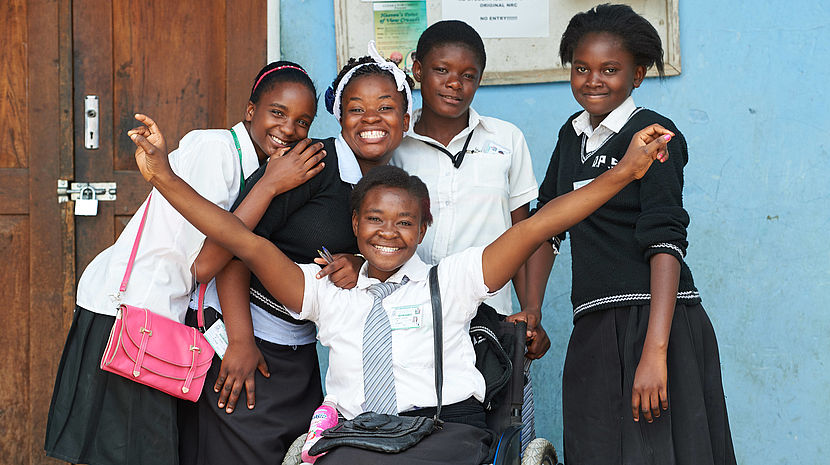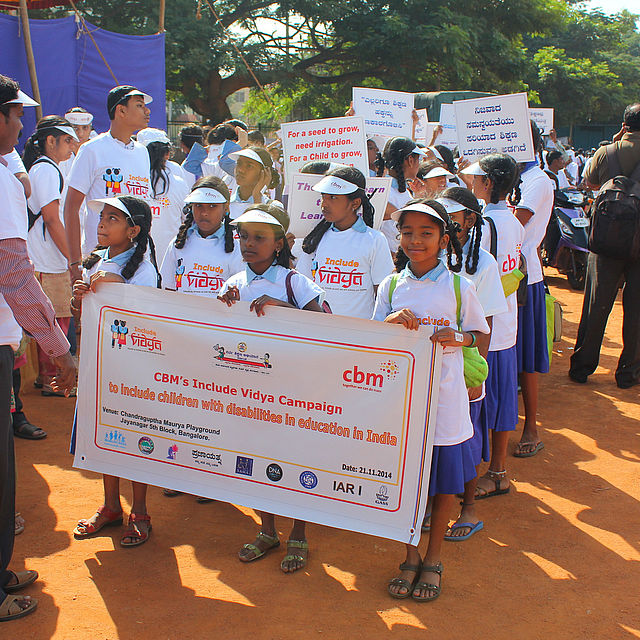The Inclusive Education Training Guide

18 year old Abigail (centre, in wheelchair) was born with spina bifida. She now goes to a school in Lusaka and dreams of being a nurse soon.
© CBM/argum/Einberger
We are launching an Inclusive Education Training Guide for CBM partners and other relevant stakeholders, designed to give participants the tools they need to train others. It has been prepared with country and regional governmental departments, NGOs and teacher training institutions in mind, but will have value for others working in project or programme management in the context of inclusive education.
Quality Education for All
CBM recognises education as a major pillar for development. Education helps improve individual and community well-being. It contributes to a nation’s overall development, sustainability, and stability. It is estimated that one extra year of schooling increases an individual’s earnings by up to 10%. Exclusion from education, on the other hand, costs countries billions of dollars annually.
CBM is committed to supporting partners and countries to realise their commitments towards the provision of quality inclusive lifelong learning for all, including learners with disabilities. Inclusive systems provide a better-quality education for all children and are instrumental in changing discriminatory attitudes. Schools provide the context for a child’s first relationship with the world outside their families, enabling the development of social relationships and interactions.
Why do we need a training guide?
What inclusive education looks like is often misunderstood. This training guide was designed and developed to have a commonly understood vision of inclusive education across the CBM network and co-operation partners. In order to provide quality inclusive education, we recognise the need for our advisors, staff and partners to have the same vision of inclusive education. Regardless of country and context, there are key underlying principles that are essential for implementing quality inclusive education.
This training package helps make education more inclusive in two ways. First, it aims to improve the entire education system so that it benefits everyone. Second, it focuses on meeting the specific needs of each student, especially those with disabilities.

The Inclusive Education Training Guide is available in English, French and Spanish
Download the Spanish version here: Guía de capacitación en educación inclusiva
Download the French version here: Formation CBM en éducation inclusive
Download the English version here
Training Guide Format
The training package is based around a number of frequently asked questions about inclusive education. Each question is followed by background information for the facilitator along with a number of activities which can be selected according to time available and participant level of knowledge / priorities. The aim is to have engaging participation and discussion to explore principles and share knowledge, understanding and promising practices. There are handouts, additional case studies and references for further reading to support further self-study.
CBM Training Guide and the pandemic
The training guide was developed over several years by experienced CBM inclusive education advisors, partners and staff and certainly pre-Covid 19. It was designed for face-to-face interaction. As with other areas of our work, our approach in delivering the content of the training guide will need to change, at least in the short term. With this in mind, we are already preparing for the first online training this August in Latin America.
When I came to this training, I felt unsure about how we can support inclusive education, but by the end I had a lot of ideas on how we can start, how to involve the community to support us and how to involve Organisations of Persons with Disabilities in advocacy....A participant of the training workshop.
Disability-Inclusive Education
How does inclusive education help bring an end to poverty, thereby leading to more inclusive societies? What are the barriers along the road and how can we overcome these? Is there a blueprint we can follow? Whom do we need to work with to reach inclusive education? To answer these questions, have a look at our publication 'The Transformative Power of Disability-Inclusive Education'.